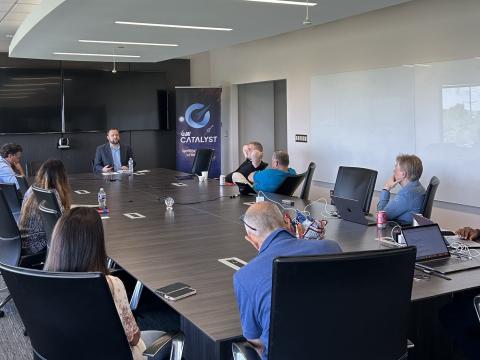Guest Blog: Budget Impact on Developing COTS Systems
The current driving force in the military and defense environment is to keep legacy systems operating longer, or the replacement of legacy systems with new systems that emulate one or more legacy systems with commercial-off-the-shelf (COTS) technology. However, there is insufficient budget to fund development of these COTS systems, and the burden of development falls upon private industry. The current sequestration environment adds another burden on industry to perform to the needs of the military, but without the benefit of nonrecurring engineering (NRE) costs being reimbursed. Programs although already funded (but not the NRE, as it is not initially funded) are being put on hold, cancelled, or are in a state of non-deterministic outcome.
Military and defense program managers and private industry face an uphill battle to find the intersection of needs, available resources and the expenditure of development costs. Small companies are at a distinct disadvantage when they develop technology to support the replacement of legacy systems when they are forced to use their own development resources without compensation and are not awarded a contract for production.
Whether a fixed-price, cost-plus, or IDIQ contract, the above scenario is increasingly commonplace in the face of budget constraints and sequestration. The burden on small companies doesn’t stop there; military program managers are also demanding engineering support without compensation for engineering-sustaining efforts, again without the presence of a production contract.
Although many systems are characterized as COTS, there are demands on the developer to perform military environment qualification testing, again without funding and no guarantee of a production contract.
Notwithstanding the above, military and defense program managers are demanding more and more burden be placed on private industry. When a small- to medium-size company quotes engineering support or development costs anywhere close to GSA Schedule rates, the reaction is swift and negative. Burden rates for engineering, test, evaluation, qualification and prototypes have less and less meaning because there is no available NRE funding in the first place.
No matter the environment of military and defense budgets, spending or sequestration, there is a cost for the development of replacement systems. Admittance to this game requires small companies to invest their own money for development and qualification.
Approximately 95 percent of all businesses in the United States are classified as small businesses. These small businesses have the technological ability to develop COTS systems that are more reliable, cost less and are more maintainable than the legacy systems they replace. But how can a small business afford the investment without NRE, or a production contract?
Small companies are faced with a business decision to invest development resources based upon a reasonable return on investment. A return of investment in less than 18 to 36 months for development costs and at least a 10 times multiplier of revenue to investment during the product life cycle is one criteria. Although each company will have its own set of return on investment criteria, these decisions will become more common and result in fewer risks being taken and less support being provided.
In today’s environment, small companies will be forced to be more selective in their decisions to undertake and support development efforts for COTS systems to replace legacy technology. The end result is a less effective warfighter.
This of course is not an acceptable scenario. Companies that demonstrate superior technology development capability coupled with realistic analysis of costs, versus return on investment, will weather the sequestration storm.
Michael Carter is the Chief Executive Officer of Sabtech Industries. As a C-level executive, Mr. Carter has a 25-year history of accelerating the growth of leading military and defense, biotechnology, telecommunications, wireless, medical, industrial and consumer product companies over his career.
The views expressed by our guest bloggers are their own and do not necessarily reflect the views of AFCEA International or SIGNAL Magazine.



Comment
Saving IT Development Costs - Using Available Capabilities
In this BLOG (Budget Impact on Developing COTS Systems) and in the December 2012, Incoming article by Paul Strassmann (Implementing the Defense Dpartment Cloud Computer Strategy Poses New Challenges); one key capability is being missed. Both articles mention issues related to the supplanting of 'legacy' systems throughout the DoD; both leaning towards COTS solutions as the viable means for solving the issue. I would propose a radical, viirtually cost-free solution and use capabilities we have. For instance, most 'legacy' systems needing replacement are database systems that could readily be replaced by a internally developed database using the listings wizards available in SharePoint (SP). Now this is predicated on the factor that the DoD (for that matter the entire federal government) should develop a top-down concept for developing their SP environments; this will allow for development of a centralized data repository (when a new field of generally used information is required, it would be added at the top level so all below would have access to the information field). This would allow for all subordinate levels (per their allowed permissions) to build views of data they need to distribute for their work; it would also prevent our current aspect of having multitudes of systems which all store variances of the same information. It would also allow for autonomous updating of information across the spectrum and would provide easily adaptable information access development. This concept would readily adapt to the current move towards cloud-based environments and due to the nature of multi-layered security built into SP, it is as secure an environment as we could expect to have (especially considring the recent gains in cloud-based assurance/certification endeavors). The only problems with enacting this type of concept lies in the various Federal Codes which would have to dramatically change to allow for enaction; for instance, in relation to the DoD, Title 10 should be adapated to formally permit development of DoD-wide systems instead of the current Service requirements being individually responsible for training and equipping their specified forces. A side benefit of this Code change would be to eliminate the need for separate acquisition communities allowing for even more significant cost savings. The more we develop this data-sharing capability, the more all aspects of the government will be able to benefit from cost-savings. As far as security is concerned; although the nay-sayers will note that 'all your eggs will be oin one basket' the preverbial basket will have the security support needed by combining the current segmented security endeavors into one common infrastructure. Additionally, if we evolve say 100+ systems we are currently attempting to secure into just one, we can spend all needed security resources towards ensuring no unauthorized access is granted.
Comments